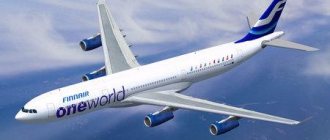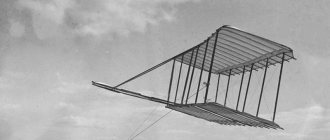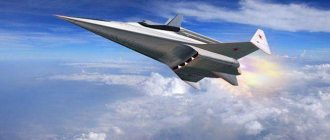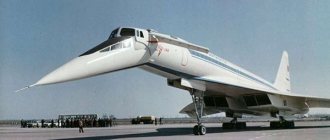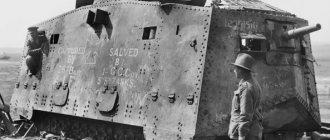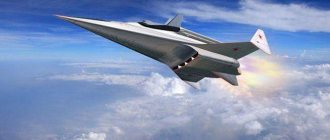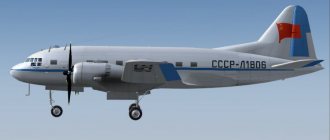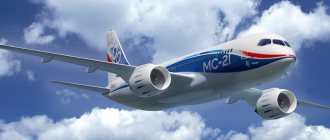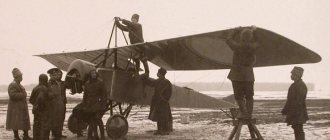One of the very first attempts by European countries to build a passenger aircraft for intercontinental flights was the construction of the experimental Bristol Brabazon airliner. The attempt was very unsuccessful.
In the 60s, the long-range 4-engine Vickers VC-10 was launched into production in Great Britain, although it did not gain much popularity. But the Boeing 747 from the USA has gained massive popularity in the international market. The American monopoly in aircraft came to an end only in the 80s, when the development of the 4-engine European airliner A340 began.
History of creation
Information about the new aircraft was first published in 1981. 6 years later, in 1987, the development program began. The a320, released a year later, lagged behind the American Boeing 747 in terms of performance, so the designers decided to take a bold step - the projected TA11 will have 4 engines. The aircraft line lacked modern medium- and long-range aircraft. The letters in the name were simply deciphered - an airplane with two aisles. From this it followed that the version should be wide-body.
In 1995, after the aircraft demonstrated its capabilities, companies began asking for a model that required less maintenance, could accommodate fewer people, and was not designed for long-haul flights. Thus was born the 200, a prime example of the saying “demand creates supply.” At the same time, market analysis showed that a radically new model is required to carry large amounts of cargo over long distances. And the factories are building two models - Airbus a340-313, a transitional model, and a340-500.
Fuel prices rose and orders for new aircraft began to fall. At the same time, it was discovered that the wing taken from the 320 version began to sag under the double weight of the engines.
In 2011, the completion of the development of the Airbus 340 model was officially announced.
Design
A340 is a 4-engine wide-body low-wing aircraft with a high aspect ratio wing. When designing, the designers tried to ensure unification with Airbus aircraft in production. Thus, fuselage sections from the A300 and A310 were used, and the fly-by-wire control system with side joysticks instead of steering wheels was from the A320. The instrument panel was initially equipped with 6 cathode-ray monitors, which were later replaced with liquid crystal ones.
The A340 wing has powerful mechanization, including 7-section automatic slats and spoilers, which also function as flaps. The wing itself is distinguished not only by its high aspect ratio, but also by its greater relative thickness and is equipped with vertical tips. Early modifications of the aircraft were equipped with CFM56 turbofan engines; later series were equipped with Rolls-Royce Trent engines.
Overview of the interior and layout of the best seats
The passenger cabin of the Airbus A340 has a three-class layout and can accommodate from 261 (A340-200 modification) to 419 passengers (A340-600 modification).
The first class cabin of the Airbus A340 can be represented by a number of seats from 6 to 8, located in one row (as shown in the diagram, this is row 1), or in two rows, which, if necessary, can be expanded and turned into comfortable beds. On some aircraft, these seats are equipped as cozy closed compartments with doors. First class passengers are provided with an exquisite menu, internet, USB charging for mobile devices, convenient screens and a multimedia entertainment system - in short, a complete package to make the flight as comfortable as possible.
However, it should be noted that first class seats located in the first row may have a number of inconveniences. The main inconvenience is that these places are located near the on-board kitchens and toilets, which ensures a steady flow of passengers and service personnel during the day and night. The bustle around these places, slamming doors and lights at night can seriously interfere with a relaxed and peaceful holiday. Please keep this in mind when purchasing first class tickets on an Airbus A340.
Next to the first class cabin are business class seats. According to the diagram, these seats are located from rows 2 to 5. The business class of the Airbus A340 is represented by comfortable and soft seats, equipped with comfortable armrests and screens installed on the backs of the seats located opposite. The menu here, of course, is not the same as for first class, but, nevertheless, tasty and restaurant-quality. The space between the seats in business class is large enough to stretch your legs, but the seats can also be reclined and turned into beds for complete relaxation. In addition, business class seats come with a set of socks and blindfolds so that nothing can disturb passengers' restful sleep.
The most unfortunate seats for business class are those located in the back row (row 5 according to the diagram), that is, directly adjacent to the toilets and galley. These places are also associated with a constant flow of people and bustle, which interferes with proper rest.
Behind business class there is a lounge for economy class passengers. The aircraft's economy class seats are located from rows 10 to 46. This class is characterized by soft, comfortable seats, the distance between which is slightly more than 80 cm, which usually does not cause inconvenience even for tall passengers, three rows of seats in the “2-4-2” option and two fairly wide aisles in the middle of the cabin. Economy class seats on the Airbus A340 aircraft are equipped with an audio and video entertainment system and convenient screens built into the backrests of the opposite seats.
The most successful and convenient seats for economy class on an Airbus are those marked with the letters A, B, K and L, located in row 31 according to the diagram. This is explained by the fact that these places do not have other places in front of them, which significantly increases legroom for them, and the toilets are not located close, which makes these places somewhat “away” from the general bustle and flow of passengers.
Economy class seats located in rows 10 and 30 are not a very good choice. The close proximity of toilets and utility rooms creates a lot of inconvenience for passengers located here. And finally, the least successful seats for economy class are rows 27 and 45.
Technical characteristics of the Airbus A340-200 wing
The Airbus A340-200 has a wingspan of 60.3 meters (area - 362 square meters). The wing itself, made of composite and aluminum, has a special profile that allows it to be used also on the twin-engine A-330 and provides a larger volume for accommodating fuel. The simplified assembly of the Airbus A340-200 reduces production costs while ensuring high operational performance.
A number of solutions (elimination of overlapping joints, few bolt holes, etc.) made it possible to increase the strength and service life of the wing. The reliability of its control is ensured by three hydraulic systems that duplicate each other. Composite materials are also actively used in the tail of the Airbus A340-200, which also reduces weight.
Motors with increased efficiency from General Electric are the result of intensive engineering work by the company's specialists. The fan efficiency is increased here, and the electronic control of the power plant ensures optimal operating modes in various conditions. As a result, the A340-200, about 60 meters long, has a maximum take-off weight of 275 tons and is capable of accelerating to 988 km/h and covering almost 15,000 km.
The Airbus A340-200 is equipped with a navigation system, which makes it possible to fly “automatically”. The cockpit differs from the A-320/321 in size and instrument panel for 4 engines. The monitors display flight information, navigation data and data on the operation of on-board systems. The comfort of control of the Airbus A340-200 is ensured by new pilot seats - with electrical adjustments in several planes.
Flight performance
Let's compare one of the later modifications of the A340 with the twin-engine Boeing 777, launched into production a little later. The 777, by the way, still remains the world's largest twin-engine airliner.
| A340-600 | Boeing 777-300ER | |
| Wingspan, m | 63,45 | 64,8 |
| Length, m | 75,36 | 75,36 |
| Maximum take-off weight, t | 380 | 351 |
| Range, km | 13980 | 13649 |
| Passenger capacity, persons | Up to 380 | Up to 390 (in three classes) |
The Boeing 777, being similar to the A340 in size and capacity (but with a single-class cabin layout could carry more than 500 people), “dry” outperformed it in terms of efficiency.
When the new Boeing was being designed, restrictions on the operation of 2-engine aircraft had already been lifted, and there was no longer a need to use 4 engines on a long-range airliner. After rising fuel prices, this advantage turned out to be decisive.
The Airbus A340 was a successful modern aircraft, as evidenced by the fact that its active operation continues to this day.
Probably, if not for the price jump, the “three hundred and fortieth” would still be produced to this day, competing with the “777”. The successor to the 4-engine Airbus was the A350 - with 2 Rolls-Royce Trent engines.
Dimensions
| Wingspan (m): | 60,3 |
| Length (m): | 59,39 |
| Height (m): | 16,7 |
In the 1970s, airlines needed a long-range aircraft that could accommodate up to 200 passengers and have optimal takeoff/landing performance. It was then that the European company Airbus began creating family A airliners, which eventually became the best aircraft of this manufacturer.
Pursuing the goals of reducing fuel consumption and generally reducing the cost of the vessel, Airbus from the very beginning embodied the most innovative solutions in its products. The engineers and management of the company saw the answer to these questions in using more economical engines, improving aerodynamics and reducing the weight of the car. The standard scheme for the crew was a combination of two specialists - the commander and the co-pilot.
At the same time, the understanding came that airliners may differ in size, capacity and some flight characteristics, but structurally, from the point of view of assembly and operation, they should be as unified as possible among themselves.
In 1982, the basic model A-310-200 took off. Then the A-319, 320, 321 appeared. The airliners aroused widespread interest, and sales grew. And Airbus did not stop: the A-330 and the four-engine A-340 appeared. This latest model was supposed to fully prove itself precisely at long distances.
Modifications and operation
The first to go into production (in parallel) were the A340-200 and A340-300 variants, which differed in fuselage length. The “200” modification had a cabin for 261 passengers, divided into 3 classes. The “300” version, due to its greater length, could carry 295 passengers.
They were distinguished by a lengthened fuselage, increased wing size and new engines manufactured by Rolls-Royce.
The 500 series airliners, which have a shorter fuselage, could carry up to 313 people, and the “long” A340-600 - up to 380. It was planned that the 500 and 600 series would replace the obsolete Boeing 747s of the early release. A version of the “600” series with an increased range and reinforced design was also being prepared for production. As a result, only 4 samples were produced, which were purchased by Qatar.
The first customers of the A340 were national airlines such as Air France and Lufthansa. It soon became clear that the shortened A340-200 was not popular.
In 1993, they managed to sell 12 aircraft, and subsequently the number of aircraft ordered per year did not exceed 5. Already in 1998, the “200” series was discontinued. The “reduced” A340 of the second generation, the “500” series, also did not find success. Over the 9 years of its production, it has never been possible to sell more than 9 copies. The reason for this was that for a liner of such capacity it was not economically efficient.
Its popularity was hit by rising fuel prices and competition from the Boeing 777 airliner. Its production began back in 1995, but after the fuel crisis, the rivalry entered a new phase, more on that below.
History of the Airbus A340
The Airbus A340 is a long-range, four-engine, turbojet, wide-body passenger aircraft developed by Airbus SAS. In general it is similar to the A330. The Airbus A340-600 was the world's longest passenger aircraft with a fuselage length of 75.36 meters until the release of an extended version of the Boeing 747-8 - 76.4 m. As of May 2006, 389 aircraft were ordered and 319 were delivered.
Story
In 1985, the Airbus development department considered the possibility of creating a 250-seat long-haul aircraft under the operating designation TA 11. The decision was soon made to simultaneously develop a four-engine A340 and a twin-engine sibling under the operating designation TA 9 (later to become the A330).
Parallel design involved reducing the cost of developing a new line of airliners.
Germany fully supported Airbus's plans, and national carrier Lufthansa volunteered to become the launch customer for the new aircraft.
Start
The A340 development program was launched in June 1987. The goal is to create a long-haul “brother” for the short-haul A320 and medium-haul A300. At that time, twin-engine Airbus aircraft were inferior to the four-engine Boeing 747 according to ETOPS standards: twin-engine aircraft during a flight must always be at a minimum distance from a possible emergency airfield in case one of the engines fails. In this regard, the A340 was a fundamentally new aircraft in the Airbus family, created specifically for intercontinental flights.
In June 1995, during the next international aerospace exhibition in Paris, the Airbus consortium announced plans to develop a new modification of the A340-200 aircraft, capable of non-stop flights on routes over 14,000 km.
During the development of the A340 aircraft, the consortium first designed a variant with a flight range of 12,400 km, which was identical in size to the A330-300. But an analysis of the development prospects of the global market showed that increased demand is expected for wide-body aircraft with a flight range of up to 14,000 km. In this regard, Airbus began creating a modification of the A340-200, which featured a fuselage length reduced by 4.26 m. The passenger capacity of the aircraft was reduced, but the flight range was increased to 13,800 km.
Flight testing of the prototype A340-300 began on October 25, 1991, and the A340-200 in April 1992. Certification of both variants according to European JAA standards was completed at the end of December 1992, and in May 1993 they received FAA certification.
At the end of February 1993, Air France received the first A340-300 aircraft. At the beginning of February 1993, the first A340-200 joined the fleet of the German airline Lufthansa. On June 16-18, 1993, the A340-200 aircraft, named World Ranger, performed a round-the-world flight on the route Paris - Auckland (New Zealand) - Paris with one stop in Auckland. This vehicle, designated A340-8000 (A340-200HGW), differed from the basic version by the presence of three additional fuel tanks in the rear cargo compartment. The entire flight lasted 48 hours 22 minutes. On the 19,100 km Paris-Auckland route, the flight time was 21 hours 32 minutes, which was recognized as a new record for this route. But this record was broken in the spring of 1997 by the American Boeing 777-200IGW.
When fuel prices went up, the Boeing 777, as a more fuel-efficient aircraft, began to outperform the Airbus in terms of the number of orders. The number of orders for the A340 has been steadily declining. In 2005, Airbus received an order for only 15 aircraft.
Initially, it was planned to install IAE (International Aero Engines) engines on the aircraft, but after the sudden cessation of IAE development, it was decided to install the CFM CFM56-5C4 engine on the A340. The A340 first took to the air in October 1991, and at the same time engineers discovered the first serious flaw of the aircraft: under the weight of four engines, the A340 wings, taken from the twin-engine A330, constantly experienced excessive vibration and sagged during flight. To eliminate this defect, the wing was modified, and the wing plastron in the area where the pylons were attached was significantly strengthened. In 1993, the aircraft entered service, the first customers were Lufthansa and Air France.
In January 2006, Airbus announced the creation of an improved version - the A340E (Enhanced). Due to the enormous increase in fuel prices in 2004-2005, sales of the A340 decreased significantly. The most popular long-haul aircraft remains the Boeing 777, but Airbus claims that the new aircraft will be significantly more economical than the first versions of the A340.
In November 2011, Airbus announced the cessation of production of the long-haul A340 airliner. “We haven’t sold a single A340 for two years,” said corporate chief financial officer Hans Peter Ring. He added that the plane could not compete with the Boeing 777.
Design
The A340 is a monoplane with a cantilever swept wing. The large aspect ratio and the presence of end aerodynamic surfaces provide high quality (10 units) and reduce inductive drag.
The wing has a large relative thickness, which increases the internal volumes for fuel. Improved load-bearing properties made it possible to reduce the area, total weight of the structure and, as a result, fuel consumption. The wing is made of high-strength aluminum alloys and composites. Monolithic panels were also widely used, which simplified assembly and reduced production costs. This also reduced the weight of the structure and reduced the number of potential areas of seal failure.
The elimination of overlapping joints and a small number of holes for bolts reduced the number of places where cracks could arise. Each console was equipped with flaps and, interestingly, seven sections of slats that occupied almost the entire length of the leading edge. Both flaps and slats were controlled automatically using the EMDS.
The wing had external aileron spoilers, which increased the efficiency of lateral control and improved the cruising aerodynamics of the wing. The fuselage is of semi-monocoque design, round in cross section. Composites were widely used in the tail structure, which significantly reduced weight.
The aircraft has a three-post retractable landing gear with articulated suspension of wheeled bogies. The nose strut has dual steerable wheels. Each main rack is equipped with two two-wheeled trolleys with tandem wheels. The braking system is automatic.
The A340 navigation systems allow the crew to fly in automatic mode. A special sensor for determining the center of gravity gives the corresponding signal to set the elevator trim. The aircraft's cabin is unified with the cabin of other aircraft of the Airbus family. The main difference is the large size, extended overhead
The instrument panel has six multifunctional displays that display navigation information as well as operating parameters of the aircraft units. New generation crew seats - with an electric control system on three axes and with a reclining backrest. The position of the pedals and the height of the armrests are adjustable. There are side control handles on the left and right.
Technologies
- The A340 has such modern systems for its time as:
- Fully digital control system
- Side joysticks (Sidesticks) controls instead of traditional steering wheels
- "Glass cockpit" based on LCD monitors
- Widespread use of composite materials
Modifications
There are 4 variants of the aircraft: the A340-200 and A340-300 were developed in 1987 and entered service in March 1993, the A340-500 and A340-600 were developed in 1997 and entered service in 2002.
A340-200
One of the first two versions of the A340, the A340-200 is capable of carrying 261 passengers in a three-class cabin configuration over a distance of up to 12,400 kilometers. This is the shortest aircraft in the family and the only one with a wingspan greater than the length of the fuselage. The aircraft is equipped with four CFM56-5C4/P engines. At the time of its creation, the A340-200 became one of the longest-range passenger aircraft, the main “specialty” of which was long-haul routes, especially over the ocean.
One of the first aircraft of this series was a special aircraft for the Sultan of Brunei, who ordered a plane with a flight range of at least 8 thousand nautical miles. The aircraft was equipped with additional fuel tanks, the maximum take-off weight was 275 tons. The range of the A340-8000 was ultimately 8,100 nautical miles (15 thousand kilometers). Unfortunately, this legendary car never reached the customer. Other A340-200 aircraft, later upgraded to the A340-8000 level, were designated A340-213X.
The large wingspan, small passenger capacity, and fuel inefficiency made the aircraft unpopular among the world's largest airlines. In total, only 28 of these machines rolled off the assembly line, of which a number were in the VIP version. The A340-200 has been discontinued.
A340-300
The A340-300 in three-class configuration carries 295 passengers. The flight range is 12,400 kilometers. The A340-300 was the first aircraft of the entire A340 family. The first flight took place in 1991, the A340-300 entered service in 1993. The aircraft is equipped with 4 CFM56-5C engines, identical to those installed on the A340-200.
The A340-313X is a higher take-off weight version first delivered to Singapore Airlines in 1995. The A340-313E is the newest version of the A340, delivered to Swiss Airlines in 2003.
The maximum take-off weight of the aircraft is 296.5 tons. Due to the installation of more powerful CFM56-5C4s engines, the flight range was increased to 13.5 thousand kilometers. The plane is no longer in production. 219 vehicles have been ordered, 211 of which have already been delivered. The largest operator of the A340-300 is the German Lufthansa with 30 aircraft.
A340-500
The A340-500 was introduced to the world as the longest-range passenger aircraft. Until the introduction of the Boeing 777-200 “Worldliner” in early 2006, it remained so.
The A340-500 made its first flight on February 11 and was certified on December 3, 2002.
The launch customer is Emirates Airlines. The A340-500 is capable of carrying up to 313 passengers over a distance of 16 thousand kilometers. For example, Singapore Airlines uses this model on its 18-hour flights to New York. The 15,345-kilometer route is the longest commercial flight in the world. The A340-500 is also capable of non-stop flights between London and Perth in Australia.
Compared to the A340-300, the fuselage of the A340-500 has been lengthened by 3.3 meters, the area of the wing and horizontal tail has been increased, the fuel capacity has been increased by one and a half times, the cruising speed has been increased, and the fin area has been reduced. The A340-500 even has video cameras installed to make the pilot's work easier while taxiing. The aircraft is powered by Rolls-Royce Trent 553 engines.
The A340-500HGW, with an increased range of 16,700 kilometers and a maximum take-off weight of 380 tons, is scheduled to enter service in 2008. The design of the A340-500HGW is essentially identical to the A340-600HGW. It is planned to install Rolls-Royce Trent 556 engines on the aircraft.
A340-600
Carrying 419 passengers in a two-class cabin configuration, or 380 passengers in a three-class configuration for a range of up to 13,900 kilometers, the A340-600 was designed as a replacement for earlier Boeing 747 models. The A340-600 has similar passenger capacity to the 747, with twice the cargo capacity of the 747. th.
The A340-600 made its first flight on April 23, 2001. In August 2002, the British airline Virgin Atlantic began its commercial operation.
The aircraft's fuselage, which is more than 10 meters longer than the A340-300, makes the A340-600 the second longest passenger aircraft in the world (less than a meter behind the 76.25-meter Boeing 747-8). The A340-600 is equipped with four Rolls-Royce Trent 556 engines. There is an additional four-wheel landing gear under the central axis of the fuselage. The A340-600HGW made its first flight on November 18, 2005, and was certified on April 14, 2006. The takeoff weight is 380 tons and the flight range is 14,600 kilometers. This became possible thanks to an increase in fuel capacity, more powerful Rolls-Royce Trent 560 engines, a strengthened aircraft structure, and also due to the introduction of new technologies in aircraft construction.
By the end of September 2010, 374 aircraft had been delivered. On November 15, 2011, some “yellow” Internet tabloids published a message about the exclusion of the long-haul passenger aircraft A340 from the catalog of aircraft available for purchase. However, only the -200 modification was excluded from production. At this time, it was believed that the -300, -500 and -600 modifications would remain in production at least until A350 deliveries began, however, due to the enormous market success of the Boeing 777, almost immediately after the modification was withdrawn -200 production of the entire A340 family was stopped.
Airbus A340 Photos
Airline aircraft
Airbus A340 interior diagrams
Specifications:
A300 A310 A318 A319 A320 A321 A330 A340 A350 A380 Aircraft
